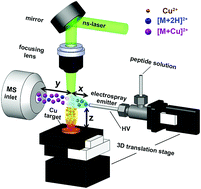Probing gas-phase interactions of peptides with “naked” metal ions†
Abstract
A novel strategy for the generation of metal–peptide complexes in the gas phase is proposed, which is of great value for probing the interactions of “naked” metal ions with peptides. “Naked” metal ions are generated from the metal target by laser ionization (LI) in open air, whereas gas-phase peptide ions are electrosprayed separately, facilitating the formation of gas-phase metal–peptide complexes. Compared to the conventional electrospray ionization (ESI) method, more control is offered for generating complexes, avoiding signal suppression and dilution effects induced by electrospraying solutions composed of metal salts and peptides. Higher stabilities of metal–peptide complexes can be obtained by a direct gas-phase reaction of peptides with “naked” metal ions devoid of counter-ions and surrounding solvent due to stronger noncovalent interactions, such as coulomb interactions and charge–dipole interactions. This approach leads a knowledge of the intrinsic properties of complexes and provides accurate gas-phase results in closer proximity to theoretical calculations irrespective of the solvent effect. The influence of the number and position of basic residues in peptides on the binding site of metal ions and CID fragmentation patterns of complexes is explored and discussed. Plausible mechanisms responsible for fragments remote from the initial binding sites of metal ions are proposed. Additionally, the diffusion model is introduced to expound on the high reaction yield of metal–peptide complexes and distribution evolution of metal ions, verified by both the calculated and experimental results.


 Please wait while we load your content...
Please wait while we load your content...